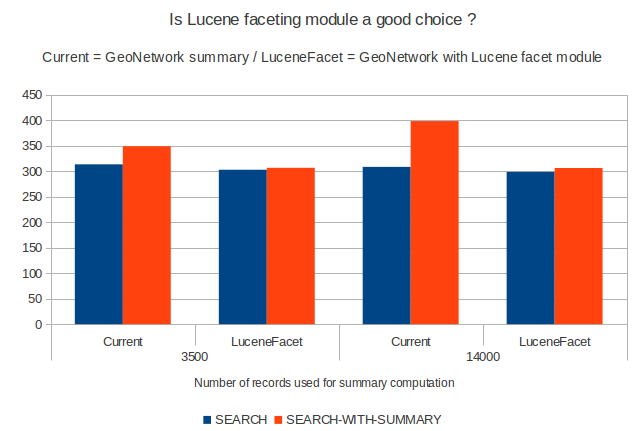| Version 8 (modified by , 12 years ago) ( diff ) |
|---|
"Narrow your search" widget
| Date | 2012/09/11 |
| Contact(s) | François Prunayre |
| Last edited | 2012/09/11 |
| Status | Ongoing |
| Assigned to release | 2.9.x |
| Resources | Resource available |
Overview
This proposal aims to provide a « Narrow your search » module aka as faceted search (http://en.wikipedia.org/wiki/Faceted_search). This module allows aggregation based on criteria (e.g. keywords, organization, dates, ...) with frequency for the current search. Output view could be a list (with link to add a specific criteria to the search) and optionnaly a tagcloud view (http://en.wikipedia.org/wiki/Tag_cloud).
On the client side, user interacts with facets using :
- the facets summary used to select new filter
- the facet breadcrumb which indicates which filter has been applied
and allows user to remove a filter.
Those 2 components are created and interact with search form and search results widgets.
A first implementation has been made on geocat.ch using the internal summary module in 2008. This proposal is using Lucene faceting module to compute the summary.
Proposal Type
- Type: GUI Change, LuceneSearcher
- App: GeoNetwork
- Module: Search Interface
Links
- Documents:
- Email discussions:
- Other wiki discussions:
Voting History
- Vote proposed by X on Y, result was +/-n (m non-voting members).
Motivations
- Improve user search experience : facets help user to quickly refine search
- Better performance : Lucene facet module using its own taxonomy index is faster than computing summary.
- New way of presenting information : facet could be use to provide catalog indicators using charts (http://www.youtube.com/watch?v=ISEOKOq6t2Q&feature=plcp)
Proposal
Facet configuration
The facet configuration define which field in the index to use to compute the summary. The configuration is stored in WEB-INF/config-summary.xml. For each facet configure the following properties:
- name: the name of the facet (ie. the tag name in the XML response)
- plural: the plural for the name (ie. the parent tag of each facet values)
- indexKey: the name of the field in the index
- sortBy: the ordering for the facet. Defaults is by count.
- sortOrder: asc or desc. Defaults is descendant.
- max: the number of values to be returned for the facet. Defaults is 10.
Configuration example:
<item name="keyword" plural="keywords" indexKey="keyword"/> <item name="createDateYear" plural="createDateYears" indexKey="createDateYear" sortBy="value" sortOrder="asc" max="40"/>
Facet response
Current implementation produce (see xml.search service) :
<response>
<summary count="4797" type="local">
<keywords>
<keyword count="1280" name="soil types"/>
<keyword count="1003" name="geology"/>
<keyword count="958" name="soils"/>
<keyword count="894" name="soil classification"/>
<keyword count="695" name="land use"/>
<keyword count="609" name="topography"/>
<keyword count="595" name="land suitability"/>
<keyword count="550" name="land"/>
<keyword count="508" name="physiography"/>
<keyword count="507" name="crops"/>
</keywords>
<categories>
<category count="165" name="datasets"/>
<category count="2" name="interactiveresources"/>
<category count="150" name="maps"/>
</categories>
<sources>
<source count="4350" name="d5a5b43b-6e52-4ec6-94af-f95c6e4dac24"/>
<source count="447" name="34475e9d-9b9e-48d1-b75c-08701c3a8f93"/>
</sources>
</summary>
<metadata>
Performance analysis
Changes
- Lucene
- Update to version 3.6.1
- New dependency : lucene-facet
- LuceneSearcher.makeSummary()
- Add an option to search services to only produce the summary (like the fast option but really fast / only summary)
- Add config file to define
- criteria : MUST be in the index
- criteria type : String|Number|Date
- agregation type :
- String : count
- Number : count|equalInterval + classe ?| quantil + classe
- Date : count|annualy|monthly|daily
- sort option (count|name)
Backwards Compatibility Issues
Risks
Participants
- As above
Attachments (4)
- geonetwork-test-on-lucene-faceting-module.png (22.3 KB ) - added by 12 years ago.
- geonetwork-faceted-search-list.png (27.8 KB ) - added by 12 years ago.
- geonetwork-faceted-search-breadcrumb.png (6.9 KB ) - added by 12 years ago.
- geonetwork-faceted-search-breadcrumb-switch.png (5.9 KB ) - added by 12 years ago.
Download all attachments as: .zip

